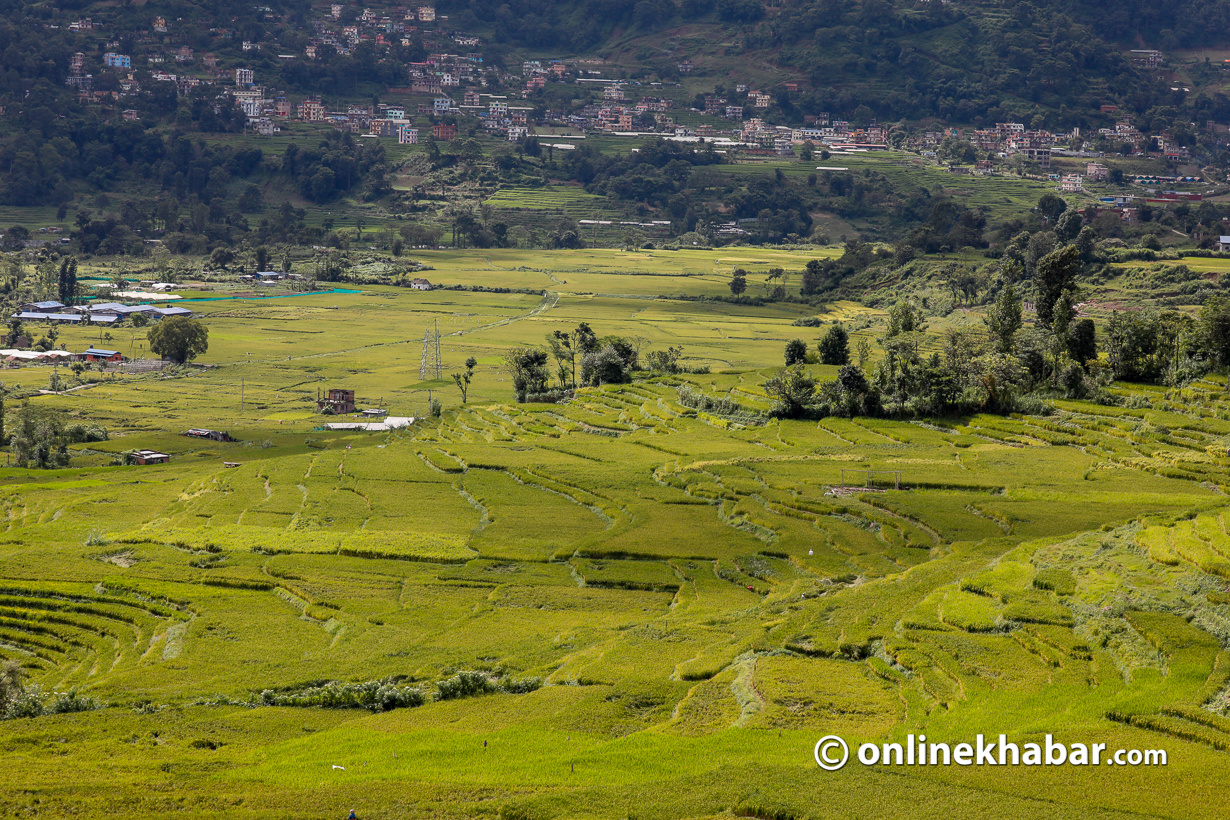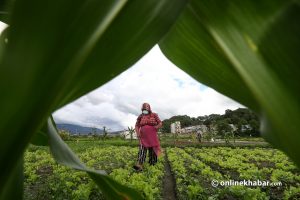Chitra Sharma got married off to Solabang, Musikot municipality of the Rukum West district in Karnali some 15 years ago. If there is one thing that she still remembers about her early years in the place, it is the soil.
“This village was known for onion and radish cultivation; other vegetables would also grow easily,” Sharma says. Following the marriage, she also decided to engage herself full-time, as a commercial farmer. Three years down the line, she was known as a successful farmer among local traders and other stakeholders in the area.
“But, for the past four or five years, there are new problems affecting my crops every time,” Sharma tells Onlinekhabar over the phone, “You cannot eat a single thing without using pesticides these days, sir. Nothing will grow (without pesticides).”
Consequently, seeds of local breeds of onion and radish are not available easily today in the place which was once a pocket area for these vegetables. “You could get seeds of local onions for Rs 500 a kilo around four years ago. Today, they are rarely available and when they are, they are as dear as Rs 3,000 a kilo.”
Today, no one except those producing and selling vegetables on a large scale cultivates onions in the village.
Shree Bhagavan Thakur, a longtime agriculture researcher in Nepal, says scores of farmers in the country share Sharma’s problem of late. Claiming such experiences are a result of climate change, Thakur and several other researchers say the list of concerns created in the sector due to the global phenomenon is a long one. But, thanks to a lack of awareness among the farmers and the government’s apathy, adaptation measures to cope with climate change’s impact on agriculture are nominal and Nepal’s long-term food security status is at stake.
The pervasive pressure
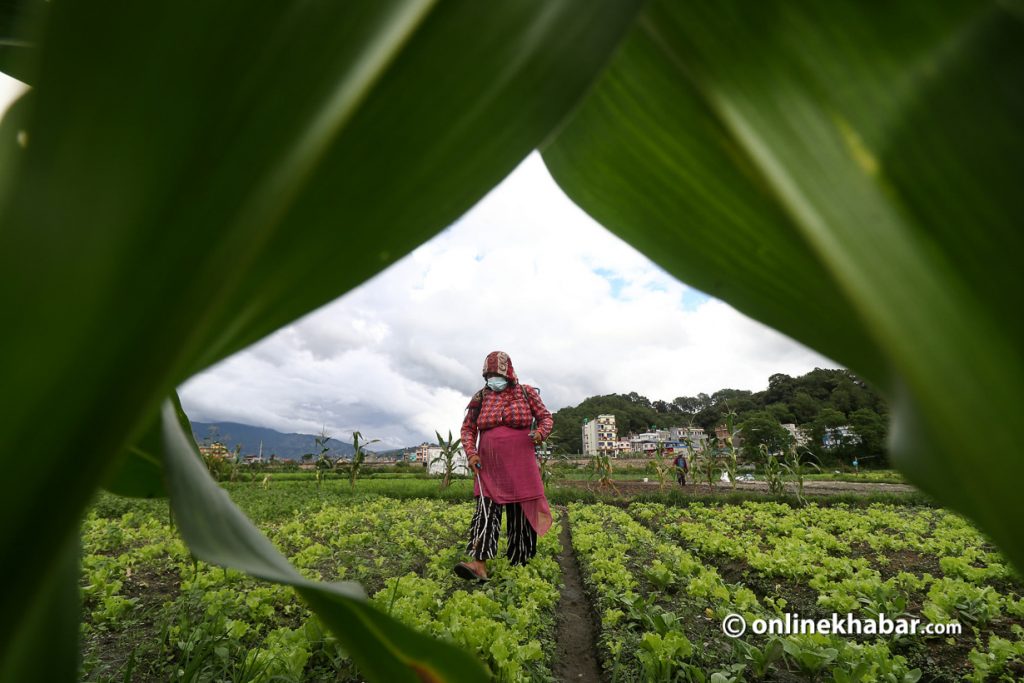
Padam Bahadur Gaha Magar, a resident of Riththe, Baudikali rural municipality of the Nawalpur district, grew up seeing his family’s orange farm. That is why, at the age of 30, he knows everything about an orange’s life. He has learned by heart what happens to an orange tree when.
But, Magar was taken by surprise two years ago as the orange calendar he had learned by heart proved wrong. “Until that year, orange flowers would come out January, but it was late February when the plants flowered that year,” he says, “Consequently, we harvested oranges over one month late last year.”
Yubaraj Subedi, who is currently in Australia for his PhD on fallow land in Nepal, had conducted a study in the Siraha district of southeastern Nepal in 2015. During that research, he met many farmers who reported similar problems. The farmers said the periods of cultivation and harvesting have changed for mango, coconut, guava, jackfruit and cereals among others. The nature’s calendar (“phenology”) of plants such as silk cotton (simal) and chinaberry/bakayan (bakaino) also changed.
| SN | Species | Past | Present | ||
| Budding month | Flowering month | Budding month | Flowering month | ||
| 1 | Mango | Jan-Feb | Feb-March | Feb-March | April-May |
| 2 | Coconut | Nov-Dec | Dec-Jan | Dec-Jan | Jan-Feb |
| 3 | Java plum (Jamun) | March-April | April-May | Mid-April | April-May |
| 4 | Guava | Mid-June | June-July | Mid-June | Mid-July |
| 5 | Bauhinia (Koiralo) | Nov-Dec | Jan-Feb | Jan-Feb | Jan-Feb |
| 6 | Jackfruit | Jan-Feb | March-April | Feb-March | April-May |
| 7 | Mung bean | Dec-Jan | Mid-Feb | Jan-Feb | Feb-March |
| 8 | Silk cotton (Simal) | Jan-Feb | Feb-March | Mid-Feb | March-April |
| 9 | Chinaberry (Bakaino) | May-June | June-July | Mid-June | Mid-July |
“Because most farmers in Nepal directly depend on natural climate for farming, the sector receives direct impacts from climate change,” Subedi says, “Hence, such phenological changes can also be considered indicators of climate change impact as per the United Nations Intergovernmental Panel on Climate Change (IPCC).”
Agriculture expert Thakur agrees. “Seeds are not everything for cultivation. You need the appropriate environment to grow anything in the desired quality and quantity. But, all components of climate such as air, water and soil are changing now.”
Because most farmers in Nepal are unaware of this, they are more at the receiving end, according to him.

Farmers and researchers say the impact of climate change on agriculture varies from place to place and from crop to crop. For example, Lekh Nath Baral, a farmer in Morang, says the size of his vegetables has decreased over the years whereas their colours and tastes have changed. Rasuwa’s Khem Raj Neupane says the number of insects attacking plants and other diseases attacking cattle has significantly increased over the years.
Thakur says the increasing presence of pests, viruses and bacteria affecting plants and animals is also related to climate change. “Our studies show the pests and viruses that can live healthy in extreme weather patterns have increased. Because climate change results in extreme weather conditions, they get an environment to breed, grow up and multiply.”
The cost of dependence
But, in principle, climate change is not the sole factor that causes the problems mentioned above. “Cultivation is affected by natural factors such as the fertility of soil and availability of water and sunlight as well as human-induced factors such as the availability of fertilisers, time table of plantation and care, and the level of hard work,” Subedi says, “All these factors are studied to identify which one is more responsible for the changes observed. But, in Nepal’s case, climate change has already been seen as the most dominant factor.”

Climate change is a global issue, but why is Nepali agriculture more affected than similar systems of other places? The answer is too much dependence on natural weather for farming. “In other countries, they have technologies to control the climate, such as greenhouses. It means they do not care much if any change happens in the outer atmosphere,” Subedi says, “In our case, we can’t afford that. Hence, any small change in natural climate will impact our crops immediately.”
But, the impact is seen outside too. Because the average temperature of the world is rising, it will cause a loss of indigenous breeds of plants and animals as they struggle to adapt to the changing climate, Thakur says, adding that is why many local variants of various species have gone extinct as shared by Chitra Sharma of Rukum.
Climate change results in drought, excessive precipitation, irregular rainfall, too high or too low temperatures, and the continuity of the same climatic conditions for a long time. Each of such effects will affect Nepal’s agricultural system, directly and indirectly, Thakur says.
In addition, climate change has made traditional instruments of Nepal’s agricultural system obsolete. “In the past, in villages of southern plains (Terai), there used to be several small ponds. Locals would use the rainwater collected there not only for their cattle but also for irrigation in small areas,” Subedi says, referring to his research participants, “Today, there are no such ponds. Rainwater does not get collected there due to either less rainfall or excessive rainfall destroying the pond altogether.”
After harvesting a crop, most of the farmers immediately use the same land plot for another crop. Hence, phenological changes for one plant means other crops are also affected, informs Subedi.
No one has assessed, officially and scientifically, the monetary value of climate change’s impact on agriculture in Nepal. Nonetheless, it has been projected that it causes a loss of 1.5 to 2 per cent of the gross domestic product, according to Thakur.
The frightening future
Irrespective of the monetary value of the climate change impact on agriculture, researchers agree the effects will be long-term. On the one hand, climate change will reduce the amount of agricultural produce; on the other, it will increase the farmers’ expenses. Gaining less than the investment is a major reason why many land plots of Nepal are fallow, according to Subedi.
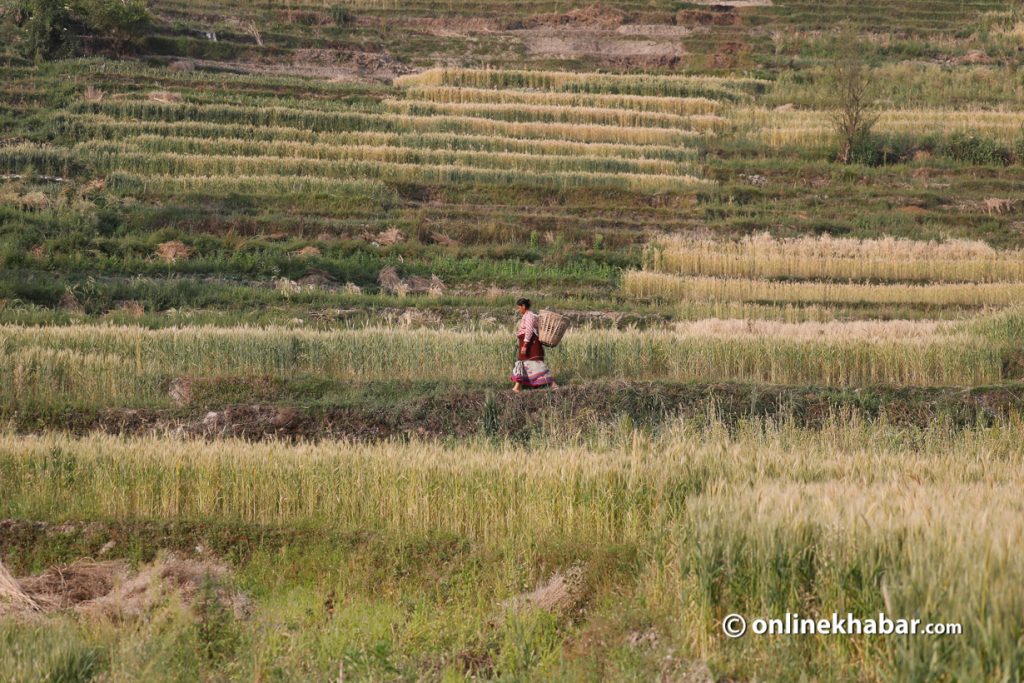
Abid Hussain, a food security economist at the International Centre for Integrated Mountain Development (ICIMOD) headquarters in Kathmandu, says climate change has directly impacted Nepal’s food security. Based on his long research in Nepal, Pakistani citizen Hussain says climate change will impact two major dimensions of food security: stability and sustainability.
Climate change results in weakened crop diversity. Hussain cites an example of a village in the Dadeldhura district of Sudurpaschim to prove his point. “People used to cultivate diverse crops and cereals there in the past. But, these days, due to climate change, crops and cereals did not grow well there, forcing locals to shift to vegetables.”
“The farmers have earned a lot from vegetable farming and they are happy about this,” he says, adding, this, however, could be an undesirable practice as they cannot feed on vegetables alone and it hence increases food dependency, which is even a bigger problem in the long run.
“It is triggering a decline of agrobiodiversity that is likely to result in low dietary diversity and less flexibility in food systems to respond to future climatic and economic shocks,” he says, “Suppose, you produce vegetables only and the roads are blocked to import other food items. It will definitely lead to a food crisis.”
He says, “So while emphasising more cash crops, production diversity based on agroecological potential should not be sacrificed.” According to him, here lies the thin line between climate adaptation and maladaptation which everyone from researchers to farmers needs to take care of.
Thakur views the case of Dadeldhura can be found in other parts of the country also. “People’s nutrition levels have compromised as they are dependent on external sources.”
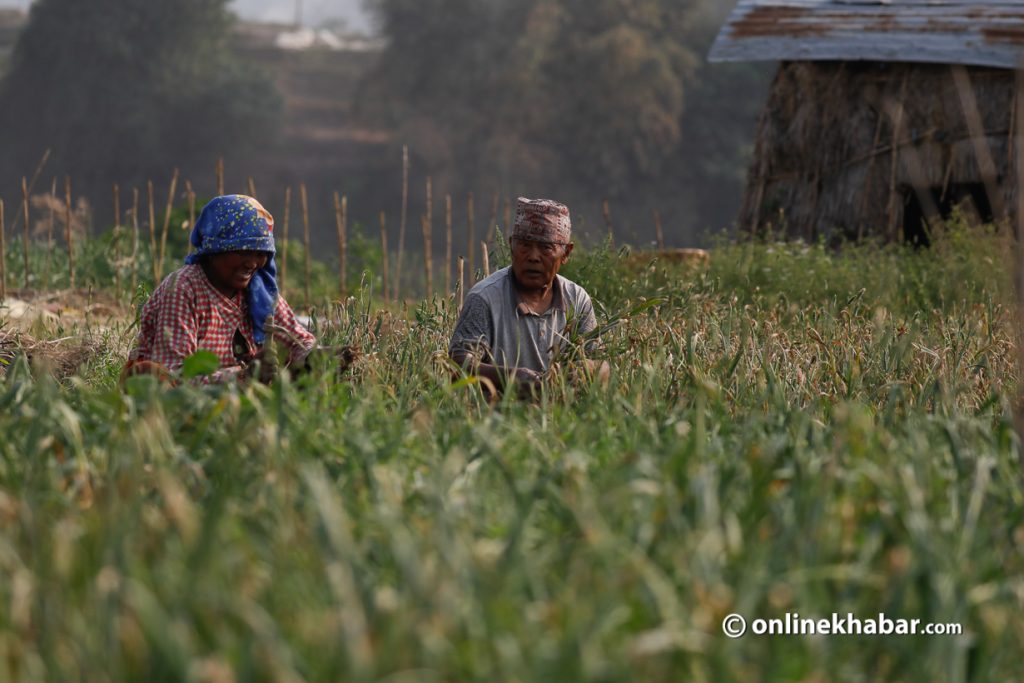
In the same way, climate change also contributes to multidimensional poverty. Hussain explains, “When climate change affects agricultural produce, a family with a limited income has to maintain a trade-off between food and non-food purchases, and it will have an impact on health, a crucial element of multidimensional poverty.” He adds, “Any impact of climate change on food security will onward impact on the level of multidimensional poverty having dimensions of health, housing, education, infrastructures and physical accessibility.”
The arduous road to adaptation
Researchers say the best way to tackle climate catastrophe in the agriculture sector is to adapt to the new environment. However, it is a difficult process, more difficult for countries like Nepal.
In Nepal, the public is not much aware of climate change, neither is the government adequately concerned. Around 10 years ago, Hussain led a study in six districts (Khotang, Dolakha, Kavre, Sunsari, Siraha and Udayapur) of the Koshi river basin in Nepal, in which only around 32 per cent of the 3,210 respondents said they have practised some adaptation.
On the government side, Agriculture Secretary Krishna Prasad Acharya says his ministry failed to mention climate change, let alone prioritise it, in 25 policy statements it issued in the past three years. “Although, indirectly, we have addressed the concerns, for example via cattle insurance and crop insurance programmes,” Acharya concedes, “Yes, climate change has not been our priority.”
“But, we will incorporate in our policies now onwards.”
Recently, with the support of the Food and Agricultural Organisation of the United Nations, the government has launched a five-year project to promote climate-smart agricultural practices in hundreds of villages across the country. Secretary Acharya says the government is expected to spend USD 700 million on this project.
The government is currently formulating a new national agricultural policy and it will adequately answer the concerns, assures Acharya. The policy is expected in a few months.
However, there is nothing much the federal government can do as the 2015 constitution authorises provincial and local governments to govern the sector, according to another official of the ministry. Agriculture expert Shree Bhagavan Thakur also agrees and demands the local governments make effective plans to respond to climate change.

But, officials doubt the efficiency of local governments to conduct research and translate research findings first to policies and then to action. Acharya, nonetheless, says through the policy, the ministry will make utmost efforts to coordinate with provincial and local governments and make them act responsively.
Yet, Nepal’s major problem is not a lack of policies but a failure to effectively implement them. Hence, the federal government should also focus on making sure all policies are implemented, says Thakur. “For example, the National Climate Change Policy has prioritised agriculture and kept it on the top of the list. Accordingly, different mechanisms have been formed up to the local level. Now, they need to work.”
There are problems in planning and budget allocation, and all of them should be dealt with, according to him.
Yet, it is easier said than done. Thakur himself says Nepal’s geography is challenging to implement a uniform policy because general climate conditions change every five kilometres. But, administratively, a single ward of a local unit, in some cases, covers dozens of square kilometres. In this case, even local government’s policies are also likely to fail to respond to the real concerns. After all, the primary responsibility lies on the farmers themselves, according to Abid Hussain of ICIMOD.
But, Hussain himself warns that locals are liable to resort to maladaptation for a want of knowledge. In this case, government and non-government stakeholders need to work together to spread awareness and run adaptation programmes in a planned way, he suggests.
If that is the case, the government will have to carry the biggest responsibility. Is it ready for that? Agriculture Secretary Acharya says, “Yes, but, we need research first. Because it is not our priority yet, it will definitely take some time.”



